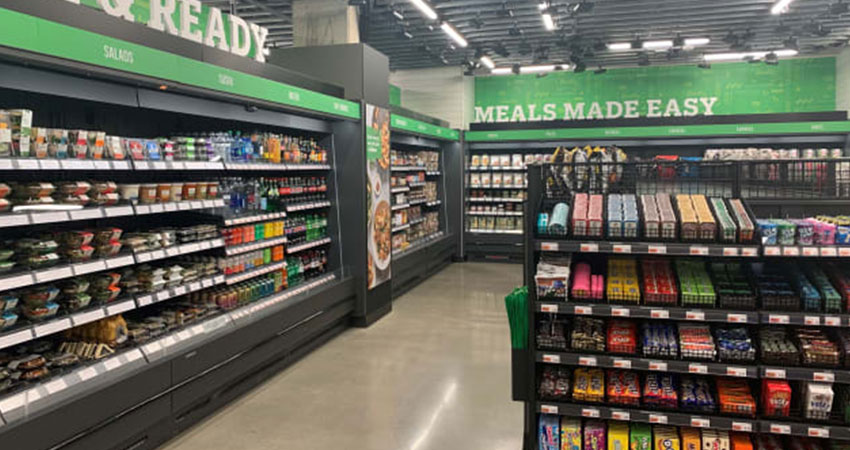Photo credit: Lauren Thomas, CNBC
Amazon’s hunger for a bigger bite of the $839 billion grocery market was evident in the Feb. 25 opening of the first checkout-less Amazon Go Grocery store in Seattle.
With e-grocery penetration of the U.S. market reaching 4.5% in 2019 and expected to hit 12% by 2025, Amazon’s menu of grocery offering now goes far beyond its $13.7 billion 2017 deal to acquire Whole Foods.
First came Amazon Go, launched in January 2018, also in Seattle, offering ready-to-consume breakfast, lunch, and snack options, a move that targeted convenience store chains like 7-11, GetGo and Cumberland Farms. Today there are 25 Amazon Go stores in New York, Chicago, San Francisco and Seattle.
“Amazon Go was really focused on serving customers breakfast, lunch and snacks in urban central-business-district areas,” Cameron Janes, Vice President, Physical Stores at Amazon, told the hometown Seattle Times. Amazon Go Grocery, Janes explained, will have “everything you’d expect to find in a neighborhood market.”
Shoppers will find fresh fruits, vegetables and meats, artisan breads, cheese and baked goods from local and regional kitchens and bakeries, as well as ready-to-heat meals. Beer, wine, and spirits are also stocked.
CNN said the new store is 10,400 square-feet, roughly five times the size of an Amazon Go store, and stocks 5,000 items.
Amazon Go and Amazon Go Grocery stores are powered by the same types of technologies used in self-driving cars: Computer vision, sensor fusion and deep learning, Amazon said. Customers need an Amazon account, the Amazon Go app, and a newer-generation iPhone or Android phone.
Consumers scan the QR code from the app at the gate to enter the store and then put the phone away. Amazon’s technology detects when products are taken from or returned to the shelves and keeps track of them in a virtual cart. When shoppers are done, they simply leave the store. Amazon sends a receipt and charges customers’ Amazon accounts. Family or friends can shop with customers if they are scanned at the gate.
No cashiers or checkout employees in Amazon Go and Amazon Go Grocery stores doesn’t mean no employees. Amazon associates greet shoppers, restock shelves, and answer questions.
The debut of Amazon Go Grocery comes amid e-grocery technology moves by competitors.
CNBC cited increasing competition, reporting that tech startups AiFi and Grabango are working on autonomous systems for big retailers competing with Amazon.
7-Eleven has opened a 700-square-foot cashier-less store near its corporate headquarters in Texas, CNBC said, noting that Walmart’s wholesale division is testing cashier-free technology a Sam’s Club Now store in Dallas.
Amazon, meanwhile, works to incorporate the approximately 500 Whole Foods stores into its portfolio. In a transcript of Amazon’s Jan. 30 call to discuss Q4 earnings, a J.P. Morgan analyst asked about the impact of incorporating Amazon Fresh into Prime and dropping the $14.99 delivery fee.
“Our grocery delivery orders from the combination of Amazon Fresh and Whole Foods Market more than doubled in the fourth quarter year-over-year,” said Brian Olsavsky, Amazon’s SVP and CFO on the call. “So we believe customers are starting to notice and take advantage of this. We will see where people’s tastes and preferences will take them. … whether they go to the store, Whole Foods, whether they use Prime Now or Amazon Delivery for their groceries. Right now, we’re really just testing and reacting to the customer demand and the customers’ preferences, and we’ll do so for the foreseeable future.”
E-grocery pickup and delivery was a key factor driving Walmart’s Q4 earnings as it competes with Kroger, Target and Amazon.

